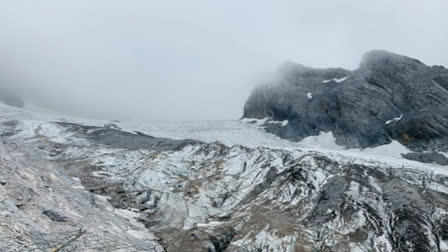New Delhi:Days after a glacier slid down in the strategically important Uttarakhand's Pithoragarh district on Saturday, Indian Space Research Organisation (ISRO) raised more alarm that speaks of the health of ever expanding glacial lakes indicating climate change at a faster rate.
The Indian space agency's analysis of decades of satellite imagery has revealed that glaciers across the Indian Himalayas—often called the Third Pole because of extensive glaciers and snow cover—are melting at an unprecedented rate, causing an alarm that needs attention to avert disasters.
The satellite imagery, which has shown significant expansion in glacial lakes in the Himalayas, spoke of more alarm especially in India, the Indian Space Research Organisation (ISRO) said on Monday. The satellite data archives spanning the past 3 to 4 decades provide valuable insights into changes occurring in glaciated environments.
Long-term satellite imagery covering the catchments of Indian Himalayan river basins from 1984 to 2023 indicates significant changes in glacial lakes. Of the 2,431 lakes larger than 10 hectares identified during 2016-17, 676 glacial lakes have notably expanded since 1984.
The danger for India
Specifically, 130 of these lakes are situated within India, with 65, 7, and 58 lakes located in the Indus, Ganga, and Brahmaputra River basins, respectively, the statement read. The Himalayan Mountains are often referred to as the Third Pole because of their extensive glaciers and snow cover.
They are considered highly sensitive to changes in the global climate, both in terms of their physical characteristics and their societal impacts. Research conducted worldwide has consistently shown that glaciers across the globe have been experiencing unprecedented rates of retreat and thinning since the onset of the Industrial Revolution in the eighteenth century.
This retreat leads to the formation of new lakes and the enlargement of existing ones in the Himalayan region. These bodies of water, created by the melting of glaciers, are known as glacial lakes and play a crucial role as freshwater sources for rivers in the Himalayan region. However, they also pose significant risks, such as Glacial Lake Outburst Floods (GLOFs), which can have devastating consequences for communities downstream.
GLOFs occur when glacial lakes release large volumes of meltwater due to the failure of natural dams, such as those made of moraine or ice, resulting in sudden and severe flooding downstream, ISRO further stated. These dam failures can be triggered by various factors, including avalanches of ice or rock, extreme weather events, and other environmental factors.
What are Hazards?
Monitoring and studying the occurrence and expansion of glacial lakes in the Himalayan region is considered challenging due to the inaccessible and rugged terrain. Satellite remote sensing technology proves to be an excellent tool for inventory and monitoring due to its wide coverage and revisit capability, the ISRO stated, adding that assessing long-term changes in glacial lakes is crucial for understanding glacier retreat rates, assessing GLOF risks, and gaining insights into climate change impacts.
Elevation-based analysis further reveals that 314 lakes are located in the 4,000 to 5,000 m range and 296 lakes are above 5,000 m elevation. The glacial lakes are categorised based on their formation process into four broad categories, namely Moraine-dammed (water dammed by moraine), Ice-dammed (water dammed by ice), Erosion (water dammed in depressions formed by erosion), and other glacial lakes.
Among the 676 expanding lakes, the majority of them are Moraine-dammed (307) followed by Erosion (265), other (96), and Ice-dammed (8) glacial lakes, respectively, the release further stated. Long-term changes in the Ghepang Ghat glacial lake (Indus River Basin) at an elevation of 4,068 m in Himachal Pradesh, India, show a 178 per cent increase in size from 36.49 to 101.30 hectares between 1989 and 2022.
The rate of increase is about 1.96 hectares per year. Satellite-derived long-term change analyses provide valuable insights for understanding glacial lake dynamics, which are essential for assessing environmental impacts and developing strategies for GLOF risk management and climate change adaptation in glacial environments, it added. (With agency inputs)
Read more
- Glacier Burst Triggers River Flood In Uttarakhand's Chamoli District
- Uttarakhand Glacier Burst Video Surfaces
- Study Reveals Invisible Glacier Loss In Greater Himalayas
